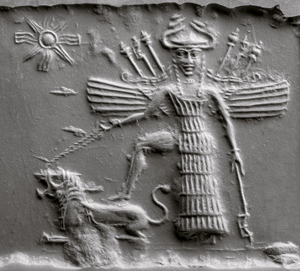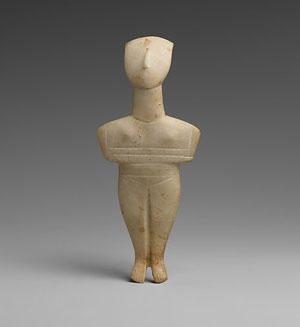Women Start Writing
John Haberin New York City
She Who Wrote: The Women of Mesopotamia
Cycladic Art at the Met
The Morgan Library attempts something remarkable—a survey of some fourteen hundred years of art and civilization and an epic succession of firsts. It has the first ever illustrated text, the first known author, and the first to speak in the first person. Were that not enough, that author was a woman. With "She Who Wrote," her voice still rings out in pride, ecstasy, anger, and pain.
The Morgan speaks of women in terms unthinkable today—and not because of an older time's sexism. So, it argues, did an entire civilization, Mesopotamia. It looks to women as "ornaments of heaven" and the first writers to speak for themselves.  Nor are they just ornaments for a male's delight. If that were not remarkable enough, too, another civilization a bit closer to Europe entirely got almost as early a start. What, then, did later centuries, with all their rules, prejudices, and rule breaking, think of the Near East?
Nor are they just ornaments for a male's delight. If that were not remarkable enough, too, another civilization a bit closer to Europe entirely got almost as early a start. What, then, did later centuries, with all their rules, prejudices, and rule breaking, think of the Near East?
Forget John Keats, at least for a moment. Spare yourself a recital of "Ode on a Grecian Urn." The Met looks back far earlier, to the origins of Western civilization in Cycladic art. As far as I know, all its creators were men, and their subjects were female, but this is not the male point of view that you may expect from Greek art. There are no warriors or their rewards, no earthly or unearthly grace. There is only the wish to journey together, to trade, and to survive.
The first I
If "She Who Wrote" sounds beyond belief, those firsts were only natural. Fourteen hundred years is a long time to break through, and they have every claim to firsts in text. After all, Mesopotamia invented writing, sometime before 3000 B.C.E., and if writing today seems essential to human society, it has a claim to have invented the complexity of civilization as well. Writing had every purpose, from official seals to recording and sustaining religious rituals. That woman, Enheduanna, began in praise of the cosmos and the temple. If her personal story seems anything but doctrinaire, she was already articulating something not strictly utilitarian.
Her own writing comes late in the story, around 2300 B.C.E. Yet women are prominent all along. Its largest, most elaborate, and most colorful sculpture, akin to assemblage, is a portrait of Queen Puabi of Ur two hundred years before her. She herself was high priestess, and her writings have survived because they served after her death as education for court scribes. If she owed her position to her talents, she was also the daughter of Sargon, founder of the Akkadian empire—unless that story arose to enshrine her prominence. The Morgan does not question it, but allow me to pay that tribute to the arts as cultural invention, just as they paid tribute to power.
I do not know how to account for the status of women in Mesopotamia, in present-day Iran, and I am in way over my head in reviewing the show at all. Still, women had a place in culture well beyond royalty. Myth elevated motherhood, with a two-tiered relief placing a hero's saga above a scene of childbirth, with the hero himself directly above the midwife. Women also appear as simply women, in sculpted portraits. They become that much more rounded, both in form and in personality, as the show draws to a close around 2000 B.C.E., when a show of African art or Western art might be barely underway. Women also have prominence in the culture's other principal medium, low relief, as in that scene of childbirth.
Who are they, and are they mythic or real? The question may not have made sense back then, not when standing portraits aspired not to likeness but essence. It is a sly essence all the same. People have the slyest of stances and smiles, in work that consistently violates frontality and symmetry. In relief, a woman might be walking a dog, were it not a wild animal, perhaps a lion, and were her dress not half so royal. As so often, headwear parallels a shining star, and a boat behind her, packed with scepters, might almost be wings.
Forgive me, then, for my presumption, but forgive the curators, Sidney Babcock with Erhan Tamur, too. Who would try to cover Western society over a similar span of time—say, from the fall of the Roman Empire to today? They begin in the cities of Sumer and Akkad, where Inanna and Ishtar were goddesses of (tellingly) both love and war, and end with King Hammurabi in Babylon. Their layout combines objects with photographic enlargements for detail and ample but not overwhelming wall text, with a lot to explain. Writing meant cuneiform, but Enheduanna's text appears thin vertical reddish stripes as itself a work of art in low relief. But then that individualization and its challenge to the status of women persists to this day.
Enheduanna (literally "high priestess, ornament of heaven") came to grief all the same, and her outcry prompted that very first I. She complains, of course, about a man for challenging her and indeed violating her. This is the first recorded sexual harassment and the first #MeToo. Thankfully later women are still smiling, even if they do not have room to say why. Other relief ranges from rituals to struggles, with overlapping figures in procession from left to right. If you have read the epic of Gilgamesh, who reigned around 2750 B.C.E. in Uruk, it was a titanic struggle, too.
An ode without an urn
Before a Grecian urn, hundreds or even thousands of years before, there was art, but not exactly Greek art. Before the great cities of Greek tragedies and Homeric myths, before there was much so much as a written language to describe them, culture flourished in a broad cluster of islands in the Aegean Sea, about midway between the mainland to the west and present-day Turkey. It had to be seagoing, for its livelihood, and it had to have a tough existence. Much of its art was created to bury with someone's remains. Now the Met does its best to bring Cycladic art back to life, but it, too, has to move on fast. It has to cover twenty-five hundred years and four civilizations.
The Met announced new galleries for Cycladic art, opening in January 2024, but did not make a fuss over the matter. There are no signs directing visitors to them, although there is more than enough verbiage inside. In practice, they come down to a single room in the galleries for Greek art, although with space for more than a hundred fifty works. You may rush right past on your way between the museum's great hall and its southern wing. Two works appear just outside, maybe just enough to arouse your curiosity. How can they look so unlike a hero, a helmet, or a Grecian urn?
 Whatever it is, it has its own appeal quite apart from its history. The standing nudes by the entrance, with no need for a pedestal, look downright modern. They influenced Constantin Brancusi, Alberto Giacometti, and Amedeo Modigliani, who felt a kinship with their very simplicity—their gentle curves, frontal poses, and approach to abstraction. One might mistake their pure white marble, abundant in the region, for limestone. Smaller figures within the galleries, almost like dolls, take the shape of violins, although violins did not yet exist either. Pablo Picasso and Cubism, with all their instruments and music, would have approved.
Whatever it is, it has its own appeal quite apart from its history. The standing nudes by the entrance, with no need for a pedestal, look downright modern. They influenced Constantin Brancusi, Alberto Giacometti, and Amedeo Modigliani, who felt a kinship with their very simplicity—their gentle curves, frontal poses, and approach to abstraction. One might mistake their pure white marble, abundant in the region, for limestone. Smaller figures within the galleries, almost like dolls, take the shape of violins, although violins did not yet exist either. Pablo Picasso and Cubism, with all their instruments and music, would have approved.
The Met has rehung it all to acknowledge Leonard N. Stern, the collector who contributed it—and to acknowledge a settlement reached with Greece, which will own the work but leave it on loan to New York. It is also a boast and a correction. Just when those Mesopotamian women were giving voice to the early Bronze age and long before Byzantine art also at the Met, others were active, too. I did not know much about the civilizations or the art, although I can take comfort that, when it comes down to it, no one else does either. Written records did not exist, and technical analysis of old marble cannot deliver authenticity or anywhere exact dates. Paint would have covered its seeming brightness, and chemical analysis can identify the pigments, in more colors than a Grecian urn.
The time line is at least as fascinating as the work. It begins before 3000 B.C.E., about as old a look at human creation as there is. It is not yet the Iron Age, so the carving of marble (with glass, the surfaces refined with emery and pumice) is quite a feat. The carvings have almost childlike features, with a recurring motif of crossed arms, and jugs have distinguishing collars and handles, but their purpose is less clear. The figures are women, suggesting hopes for fertility for a people that knew endless deaths. Yet they are barely female—their hips and breasts as flat as, well, a violin.
The room turns to the Minoan civilization in Crete, after roughly 2000 B.C.E., and then to Myceneans on the mainland, after 1000 B.C.E.. More familiar Greek art, with kraters, or (sure enough) vases in red against black or vice versa, did not begin until around 700 B.C.E., and the Green alphabet emerged not long before. Minoan and Mycenean culture also runs to more useful and decorative art, like pins for clothing and seals, with real or imagined animals. The Greeks changed everything with their focus on youths and men, as warriors and most often in groups, in procession. Their patterns are less bold and their figures more sketchy than Cycladic art, and they cannot honor the dead one by one, but they could be more broadly imagined as ancestors. What to make of the new masculine values, even in light of Homer, is a fascinating question in itself.

"She Who Wrote" ran at The Morgan Library through February 19, 2023. The Met's galleries for Cycladic art reopened January 25, 2024.




